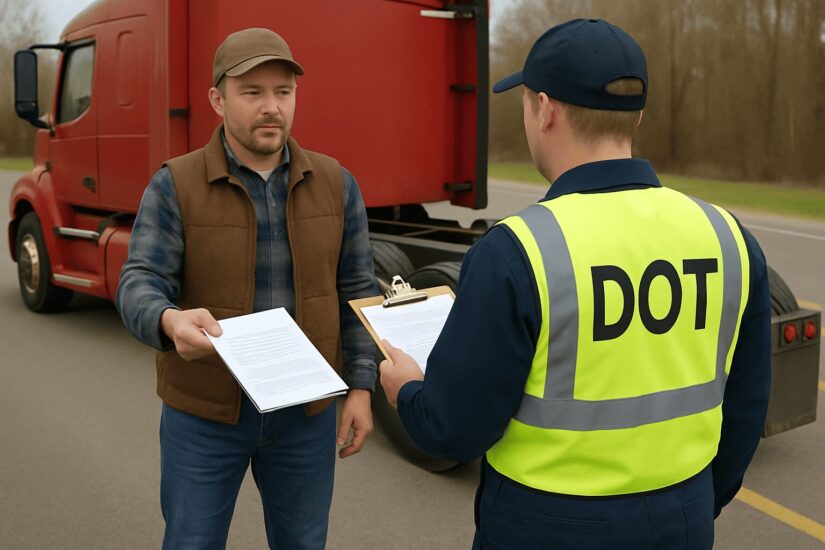
If you work in the trucking industry, you are probably aware of all the DOT inspections that occur in order to ensure you are compliant with FMCSA rules and regulations. These inspections are usually carried out by a state police officer or a DOT inspector, and there are six different levels of inspections that they can carry out to determine whether or not you are compliant. Passing these inspections is crucial to avoid any bumps in the road, so in this blog, we will be covering all six levels of DOT inspections to make sure you are prepared for yours.
Level 1 DOT Inspection: North American Standard Inspection
This first level of DOT inspection is the most common and most thorough inspection, as it consists of a complete check of the driver and their vehicle. Throughout this inspection, the inspector will examine driver documentation such as license, medical certificates, logs, HOS documentation, inspection reports, and Hazmat endorsements.
In addition to reviewing these documents, the DOT inspector will also verify that the driver is not under the influence of alcohol, drugs, or any other harmful substances. From here, the inspector will conduct a complete check of the vehicle, verifying that cargo is secured correctly, and that seat belts, brakes, suspensions, tires, windshield wipers, headlights, turn signals, steering wheels, and fuel systems in adequate condition.
Level 2 DOT Inspection: Walk-Around Driver and Vehicle Inspection
This second level of DOT inspection is very similar to the first level inspection, except for one small part of the inspection regarding the vehicle. Rather than conducting a full vehicle inspection, the official will only check the parts of the vehicle that are accessible without having to physically get under it.
Level 3 DOT Inspection: Driver Only Inspection
This third level of DOT inspection is focused on looking into the driver’s credentials. Here, officials check the driver’s licenses, endorsements, medical card, skill performance evaluation certificate, RODS, HAZMAT requirements, vehicle requirements, vehicle inspection report, and HOS documentation. The inspector will also review seat belt usage and use of alcohol and/or drugs.
Level 4 DOT Inspection: Special Inspection
The fourth level of DOT inspection involves a one-time check of a specific item. This inspection is conducted to verify or deny a possible trend carried out during DOT inspection. The specific item that can be inspected varies with each inspection.
Level 5 DOT Inspection: Vehicle-Only Inspection
The fifth level of inspection involves the vehicle inspection from the first level inspection, but it can be conducted without the driver present. The DOT official will check brakes, fuel cargo, exhaust, steering, lighting, suspensions, tires, steering wheel, trailer, and more.
Level 6 DOT Inspection: Enhance NAS Inspections for Radioactive Shipments
Finally, the sixth DOT inspection level is strictly conducted for drivers hauling radioactive freight. This inspection involves an advanced level one inspection, along with a check for radiological shipments, requirements, and enhanced out-of-service criteria.
Before leaving for delivery, the vehicle, driver, and cargo must all be confirmed to be defect-free before they can leave for delivery. If the driver passes this inspection, the official will grant a decal, valid for one trip to the delivery destination.
Now that you have become familiar with the 6 levels of DOT inspections, all that it takes to pass these inspections is to implement the practices necessary to stay compliant with regulations. Staying organized with regular maintenance, following of safety standards, and keeping paperwork organized will ensure you pass these inspections with flying colors.

What does a Level 1 DOT inspection cover and how long does it usually take?
A Level 1 is the North American Standard inspection: a combined driver + vehicle exam (documents, hours-of-service, CDL/medical, alcohol/drug checks) plus a full vehicle systems check (brakes, tires, lights, suspension, cargo securement, etc.). It follows a detailed procedure (commonly referenced as a 37-step check) and typically takes ~30–60 minutes depending on findings and complexity
What is a Level 6 inspection and when would it apply to my truck?
A Level 6 is an enhanced North American Standard inspection performed when a vehicle is transporting radiological materials (highly regulated shipments). It includes all Level 1 checks plus additional radiological-shipment assessments and often requires inspectors with specific training/certification for hazardous/radiological cargo. You’ll only see it applied when the load contains controlled radioactive material or when radiological compliance must be verified.